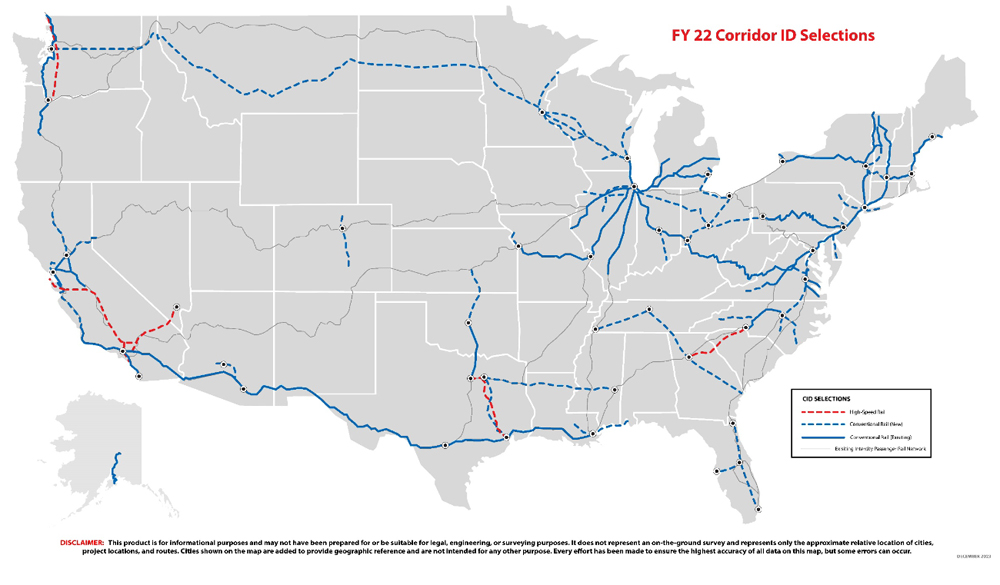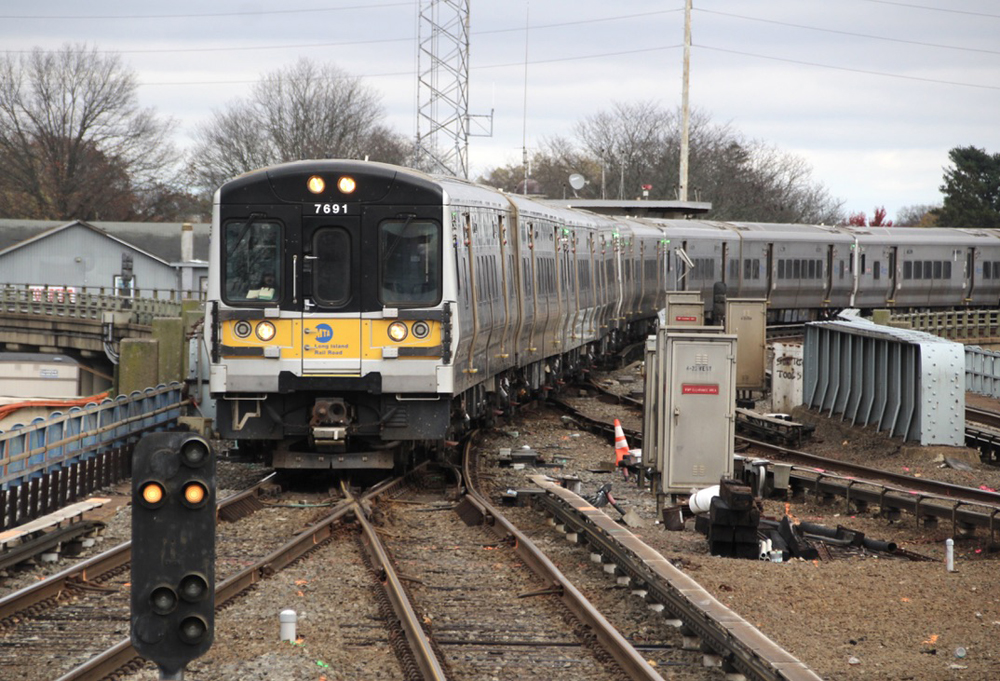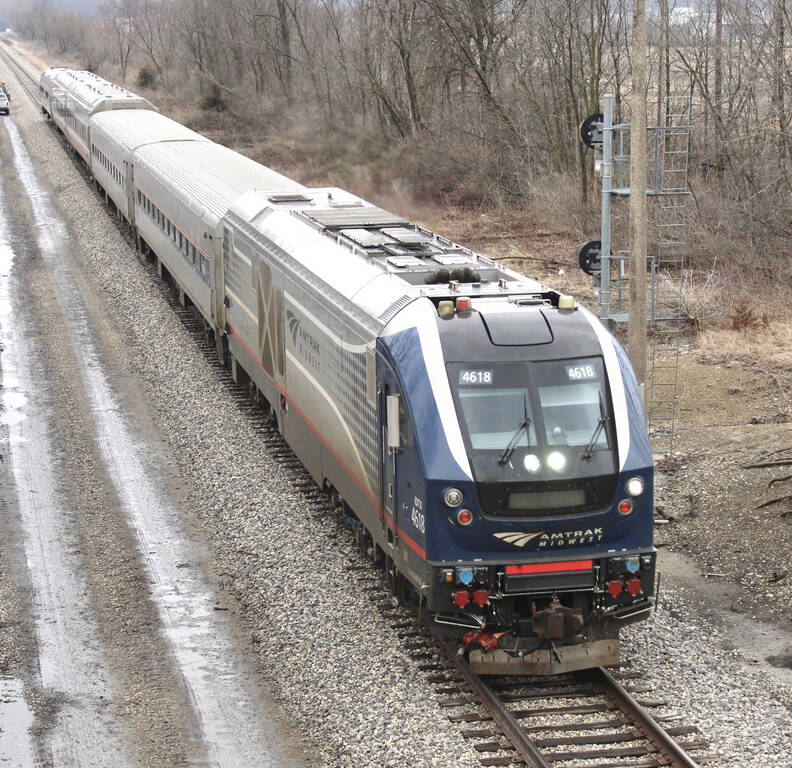
WASHINGTON — The Federal Railroad Administration has released its list of routes selected for the first step of its Corridor Identification and Development Program, a catch-all group of 69 potential future Amtrak routes, possible extensions to existing routes, efforts to increase service on existing routes, and future high speed rail systems.
Thirty-three of these routes had previously been reported by Trains News Wire as they were announced by elected officials; in the lists below, they are indicated with italics.
The vast majority of routes are corridor services that will require state support, but among the routes seeking increased service are Amtrak’s two current triweekly long-distance trains, the New York-Washington-Indianapolis-Chicago Cardinal and the Los Angeles-New Orleans Sunset Limited.
Selection is the first phase of a process that could take as much as seven to 10 years before service begins on new routes, according to some of those involved. It brings a $500,000 grant to be used to create a Service Development Plan, which estimates the cost and timeline for launching service, among other features. That grant goes to the organization that applied for inclusion in the program, indicated in parentheses on the lists below.
The selections were presented in four categories: new routes, existing routes with extensions, existing routes, and high-speed rail.
FRA Administrator Amit Bose said in a statement that the agency is “taking full advantage of the resources we have to advance world-class passenger rail services nationwide. Today’s announcement is another step forward as we advance transformative projects that will carry Americans for decades to come and provide them with convenient, climate-friendly alternatives to congested roads and airports. We’re thinking about the future too with comprehensive and systematic planning efforts to transform the U.S. intercity passenger rail network now and in the years to come.”
New routes
A total of 34 new routes were selected; some are in advanced stages of planning and others have essentially been previously unknown. They are:
— Asheville-Salisbury, N.C. (North Carolina Department of Transportation)
— Atlanta-Savannah, Ga. (Georgia DOT)
— Atlanta-Chattanooga-Nashville-Memphis (City of Chattanooga)
— Baton Rouge-New Orleans (Louisiana Department of Transportation and Development)
— Boston-Springfield, Mass-Albany, N.Y. (Massachusetts DOT)
— Charlotte-Kings Mountain, N.C. (North Carolina DOT)
— Chicago-Quad Cities (Illiinois DOT)
— Chicago-Fort Wayne-Columbus-Pittsburgh (City of Fort Wayne, Ind.)
— Chicago-Peoria (City of Peoria, Ill.)
— Cleveland-Columbus-Dayton-Cincinnati (Ohio Rail Development Commission)
— Cleveland-Toledo-Detroit (ORDC)
— Delaware “Diamond State Line” — Newark/Wilmington-Dover-Salisbury/Berlin (Delaware Transit Corp.)
— Dallas-Meridian, Miss. “I-20 Corridor” (Southern Rail Commission)
— Dallas-Fort Worth-Houston “Texas Triangle” (Texas DOT)
— Eau Claire, Wis.-Twin Cities (Eau Claire County)
— Fayetteville-Raleigh, N.C. (North Carolina DOT)
— Fort Collins-Denver-Pueblo, Colo. “Front Range Corridor” (Front Range Passenger Rail District)
— Houston-San Antonio (Texas DOT)
— Jacksonville-Orlando-Miami (Florida DOT)
— Los Angeles-Coachella, Calif. “Coachella Valley Corridor” (Caltrans)
— Louisville-Indianapolis (Kentuckiana Regional Planning and Development Agency)
— Miami-Orlando-Tampa (Florida DOT)
— Milwaukee-Madison-Eau Claire-Twin Cities (Wisconsin DOT)
— Minneapolis-Duluth, Minn. “Northern Lights Express” (Minnesota DOT)
—Newport News-Richmond-Charlottesville-New River Valley, Va. “Commonwealth Corridor” (Virginia Department of Rail and Public Transportation)
— New Orleans-Mobile, Ala. “Gulf Coast service” (Southern Rail Commission)
— “North Coast Hiawatha” — Chicago-Seattle/Portland via southern Montana (Big Sky Passenger Rail Authority)
— Phoenix-Tucson, Ariz. (Arizona DOT)
— Reading-Philadelphia-New York (Schuylkill River Passenger Rail Authority)
— San Jose-San Luis Obispo, Calif. “Central Coast Corridor” (Caltrans)
— Scranton-New York (Pennsylvania DOT)
— Twin Cities-Milwaukee-Chicago expansion (Wisconsin DOT)
— Wilmington-Raleigh, N.C. (North Carolina DOT)
— Winston-Salem-Raleigh (North Carolina DOT)
The hodgepodge nature of the Corridor ID program is illustrated by programs ranging from the nearly ready to run, such as the Gulf Coast route, to those that seem rather hastily assembled, like the Delaware proposal that has yet to define endpoints. The second train on the Empire Builder route between Chicago and the Twin Cities is for some reason classified as new service rather than fallling into the existing route categories below.
Existing routes with extensions

Some 13 routes fall into this group:
— Amtrak to Long Island (Amtrak): A proposal to extend three existing Northeast Regional round trips between Washington and New York to Ronkonkoma, N.Y., on the Long Island Rail Road, with intermediate stops at Jamaica and Hicksville.
— Capitol Corridor (Caltrans): Would add to the existing San Jose-Auburn, Calif., corridor with extensions to San Francisco, Salinas, and Novato, Calif., and Reno/Sparks, Nev.
— Downeaster Corridor (Northern New England Passenger Rail Authority): Would extend the route to Rockland, Maine, add additional frequencies, add an infill station at West Falmouth, Maine, and make improvements to allow better connections in Boston, where the Downeaster uses a different station than all other Amtrak services.
— Green Mountain Corridor (Vermont Agency of Transportation): Would connect New York and Burlington, Vt., via Albany, N.Y.,and Rutland, Vt., dovetailing with the Ethan Allen Express by providing new service to communities including Bennington and Manchester, Vt., and Mechanicville, N.Y.
— Extension of Chicago-Quincy corridor to Hannibal, Mo. (Missouri DOT): Would extend the route currently used by the Ilinois Zephyr/Carl Sandburg.
— Heartland Flyer extension (Kansas DOT): Would extend the current Fort Worth-Oklahoma City train northward to Wichita and Newton, Kan., where it would connect with the Southwest Chief [see “Kansas DOT holds public meeting …,” Trains News Wire, Nov. 10, 2023].
— Kansas City, Mo.-St. Joseph, Mo. (Missouri DOT): Would provide a connection with the existing Missouri River Runner.
— San Luis Obispo-San Diego LOSSAN Rail Corridor (Caltrans): Proposes a small extension — from its current southern endpoint of San Diego to San Ysidro, Calif, about 16 miles — as well as additional frequencies and improvements to reliability.
— Milwaukee-Green Bay Hiawatha extension (Wisconsin DOT): Would extend the existing Chicago-Miwaukee service.
— San Joaquin Valley Corridor (Caltrans): Would extend the existing service north from Sacramento to Chico and Redding, Calif., while also increasing frequencies.
— Vermonter Corridor (Vermont Agency of Transportation): Would extend service north to Montreal, with creation of a customs preclearance facility at Montreal’s Central Station, add frequencies, and reduce travel time.
— Washington to Bristol, Va. Corridor (Virginia Department of Rail and Public Transportation): Would extend existing Northeast Regional service between Washington and Roanoke Va, to Bristol; add an infill station at Bedford, Va.,. and increase frequencies.
— Wolverine Corridor (Michigan DOT): Would extend service to Windsor, Ontario, and include improvements to travel time and reliability.
Existing routes

These 15 routes — eight of them previously reported — seek additional frequencies or other infrastructure improvements, with other details as noted:
— Adirondack Corridor (New York State DOT): Seeks a custom preclearance facility in Montreal
— Amtrak Cascades Corridor (Washington State DOT)
— Anchorage North and South Corridor (Alaska Railroad Corp.)
— Charlotte-Washington Corridor (North Carolina DOT): Seeks improvements including the Raleigh-to-Richmond project that received a $1.1 billion Federal-State Partnership grant.
— Chicago-Carbondale Corridor (Illinois DOT)
— Chicago-Grand Rapids Corridor (Michigan DOT)
— Chicago-Port Huron Corridor (Michigan DOT)
— Chicago-St. Louis Higher-Speed Corridor (Illinois DOT)
— Daily Cardinal service (Amtrak)
— Daily Sunset Limited service (Amtrak): Like the Cardinal, would be increased from the current triweekly schedule.
— Empire Corridor (New York State DOT)
— Hartford Line Corridor (Connecticut DOT)
— Indianapolis-Chicago Corridor [Indiana DOT]: Could the Hoosier State live again? Indiana says it seeks new frequencies and improved travel times on this portion of the Cardinal route, and is undertaking this effort in connection with the daily Cardinal project.
— Keystone Corridor (Pennsylvania DOT): A selection tied to the $143.6 million Federal-State Partnership grant for improvements between Pittsburgh and Harrisburg.
— Milwaukee-Chicago Hiawatha Corridor (Wisconsin DOT): Previous efforts to increase service were shot down by objections in Glenview, Ill., to a siding that was part of an agreement between Amtrak, Canadian Pacific, and the other parties involved.
High speed routes
While clearly projects of a different nature than those above — both in orders of magnitude of expense and timeline for development — high-speed projects have been included in the Corridor ID program, presumably because selection is a key to eligibility for other forms of federal funding. Only the Charlotte-Atlanta project had previously been mentioned as part of the Corridor ID program in announcements by legislators, although the California and Brightline West projects received major federal funding in the Federal-State Partnership program.
— Dallas-Houston (Amtrak)
— Fort Worth-Houston (North Central Texas Council of Governments)
— Brightline West (Nevada DOT)
— California High-Speed Rail phase 1 (California High-Speed Rail Authority)
— Cascadia corridor — Vancouver, British Columbia-Portland, Ore. (Washington State DOT)
— Charlotte, N.C.-Atlanta, Ga. (North Carolina DOT)
— High Desert Corridor — Victor Valley-Palmdale, Calif. (Antelope Valley Transit Authority)
Notably, there are competing Texas high speed projects. Amtrak has joined with the Texas Central project, while the North Central Texas group would include both Dallas and Fort Worth; the latter was left out of the Texas Central plan. Like the other projects, these receive $500,000 grants, which likely won’t go very far for high speed planning.
— Updated at 11:32 a.m. CST with comment from FRA Adminstrator Amit Bose.














Now I know that some of the things that I am about to propose would be controversial, but here goes. First, the tracks on many of these new routes will probably need to be replaced. The Federal government could condemn the tracks and seize the right-of-way by eminent domain. In replacing the tracks Amtrak could make sure that there are large enough bypasses to fit long freight trains. They could then lease rights to use the tracks to the freight companies to pay for maintenance. Amtrak could also have their own dispatchers to give passenger trains priority as is written in the law. They could also limit the length of freight trains to insure minimal interference. I know that the freight companies might balk at these ideas, but better tracks and traffic control would benefit their business. I think that the government could recommend that an independent company be formed to purchase all tracks in the USA, to maintain and lease all the tracks to the railroads as a for profit business. This would make a single entity responsible for the quality of the rails like the Federal Interstate system should do for the highways.
Amtrak can’t run what they have now.
Millions will be spent on route studies and environmental impacts.
No new trains for a decade,maybe.
need to get the old amtrak run back through boise to salt lake got plenty of track
yea ok calif cant even get the calif high speed rail done with all the billions of dollars its costing still cost over runs we are not europe lol
In Europe most political parties support passenger rail.
In the U.S.A. the Republicans don’t seem to.
So my opinion is that this massive plan will only go ahead if Democrats win elections in both houses and the executive and do so for as long as the FRA Corridor plan takes to complete.
Mr. Lustig, did anyone submit the ones you ask about into the corridor ID program? If not, then they are just like South Carolina – no submittal, no study.
What happened to the proposal to extend an Empire corridor train to Cleveland as well as running a Cleveland to NY train via Pittsburgh?
Also why not extend one of a Carbondale train to Memphis or Jackson, MS?
What about extending the new CHI-MSP train to Fargo or Grand Forks?
The above mentioned trains would be quicker to start than a new service which if a new route were to happen it’s a decade out and Amtrak still hasn’t placed an order for new long distance cars.
Because they don’t spend enough money. You get bragging rights by how much money you spend, not by results. Columbus-Pittsburgh is going to be a real treat to see since pieces are missing and remainder is low speed now.
Two glaring omissions: Chicago-Florida and New Orleans-Jacksonville.
And one not so much: Laramie-Albuquerque
I will add Salt Lake City-Boise, which was also gaining support. Wonder if extending it to Portland/Seattle would have helped?
Large chunks of all three of those received funding (Memphis-Atlanta, New Orleans-Mobile, and Fort Collins-Pueblo).
Exactly, bring back the old “Floridian” route. Indianapolis to Nashville would connect.
The Reading-Philadelphia-NY service would entail only 41 new miles, from Reading to SEPTA’s Norristown De Kalb St. Station. From there the train would use SEPTA track to Center City, pasing under Amtrak’s NEC near North Broad St., then looping via SEPTA’s Temple U., Jefferson, Suburban and 30th St (Upper Level) Stations, joining Amtrak’s NEC at “ZOO” and passing over SEPTA, crossing the same bridge as above at North Phila. Station; then it would be a straight shot to Penn Station or Gateway NY City. The loop would take about 30 minutes.